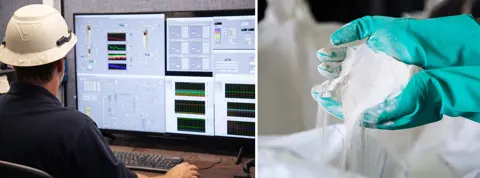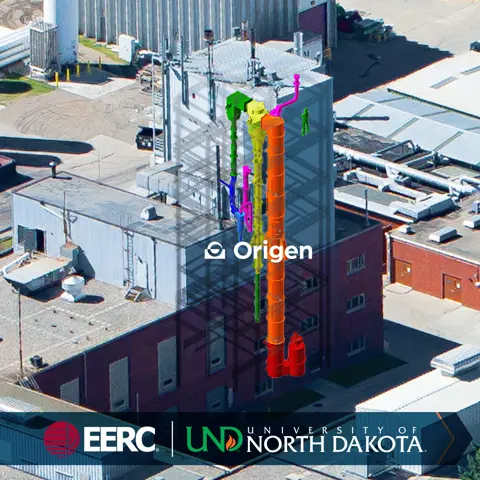
Origen’s Zero-Emission Kiln Commissioned at Demonstration Facility
A critical, often overlooked step in DAC - and a competitive edge for Origen
At Origen, we’re building a new pathway for removing carbon dioxide from the atmosphere — one that leverages the natural chemistry of limestone, one of the most abundant materials on Earth. Limestone-based Direct Air Capture (DAC) has the potential to deliver durable, scalable carbon removal while also supporting industrial decarbonization.
The journey from limestone to carbon removal begins by making the material reactive to CO₂, a process that takes place in the kiln. This month, Origen reached a major milestone: commissioning our proprietary zero-emission kiln at the Energy & Environmental Research Center (EERC) in North Dakota.
At more than seven stories tall, this kiln is capable of enabling over 2,000 tonnes of CO₂ removal per year. It’s the first of its kind: a large-scale, zero-emission lime production system designed specifically for DAC.
How Origen’s Limestone-Based DAC Cycle Works
The kiln is step one in Origen's DAC cycle:
- Kiln: Our proprietary kiln prepares limestone by driving off the CO₂ it contains, producing high-performance lime and a pure stream of CO₂. The pure CO₂ is transported from the kiln and permanently stored.
- Lime Processing: We use a proprietary process to maximize lime’s ability to remove CO₂ from the air and ease materials handling challenges.
- Contactor: The processed lime reacts with atmospheric CO₂ in Origen’s proprietary air contactor, capturing it and re-forming limestone, which is then fed back into the kiln.
Without step one, the cycle cannot begin – and as of today, there is no commercially viable production of zero-emission lime anywhere in the world.
The Kiln: Built for Carbon Removal
Limestone naturally contains the ingredients to CO₂. To make it useful for Direct Air Capture, that CO₂ must first be released through a reaction called calcination, leaving behind lime. This lime must be highly reactive to effectively capture CO₂ from the air.
The kiln, also known as the regeneration step, is one of the most technically demanding and costly parts of limestone-based DAC. A DAC-ready kiln must:
- Efficiently convert limestone into lime at high calcination extents.
- Produce lime with the reactivity needed for rapid CO₂ capture.
- Generate a pure CO₂ stream free of contaminants for reliable storage.
- Operate with an energy system that is low-cost and scalable at sequestration sites.
Origen’s oxy-fuel flash calciner design meets all of these requirements. Direct-fired for efficiency and fuel-flexible to avoid renewable power bottlenecks, it is engineered for integration into the full DAC system. We believe developing this component in-house is critical, allowing us to eliminate partner risk, optimize system costs, and accelerate innovation and efficiency across the full process.
While Origen’s priority is DAC, our zero-emission lime also creates opportunities for other carbon removal pathways and industrial decarbonization, expanding our potential for climate impact.

Addressing DAC’s Energy Dilemma
Energy use underpins every Direct Air Capture system, whether it’s regenerating a sorbent or moving vast volumes of air through contacting devices. The cost, availability, and carbon footprint of that energy will ultimately make or break DAC’s cost curve and its ability to scale. Today, most approaches are constrained by the limited availability of firm, low-cost renewable electricity.
Origen takes a different path. Our fuel-flexible kiln captures all emissions from the fuel it uses, allowing us to run on natural gas, renewable natural gas (RNG), biogas, or hydrogen and still be highly carbon negative in all cases. Because our system is primarily thermal, it avoids competing for scarce renewable power needed elsewhere and is well-positioned to benefit as alternative fuels like RNG and hydrogen mature.
This approach lowers costs today, enables near-term deployment, and will allow Origen to scale faster – deploying where sequestration sites and infrastructure make sense, not just where renewables are abundant.
Why This Milestone Matters
The successful commissioning of our large-scale demonstration kiln marks a major step forward for Origen:
- A patented, novel design proven at meaningful scale.
- De-risking of a critical component ahead of commercial deployment.
- Clear progress toward integrated large-scale testing of our end-to-end DAC system.
We are also advancing rapidly toward commercial scale with our engineering partner Hatch, supporting front-end design work for Origen’s first commercial deployment. That work is primarily centered on the Pelican DAC Hub in Louisiana, a partnership with Shell and Mitsubishi that will serve as a cornerstone project for bringing Origen’s technology to market.
"We're proud to be part of this key milestone in the advancement of Origen's DAC technology. Building on a fuel-flexible system and equipment proven in other industrial applications, the commissioning of the kiln at the EERC advances the deployment of a scalable and low-electricity DAC process." - Gino De Villa, Hatch Decarbonization Technologies Lead
Why We’re Partnering with EERC in North Dakota
The Energy & Environmental Research Center (EERC) is one of the most credible hosts in the world for this demonstration. With decades of experience building and operating large pilot systems, and a long track record in energy and carbon capture, EERC is uniquely equipped to help Origen advance from demonstration to commercial deployment.
The People Behind the Milestone
This milestone wouldn’t have been possible without the team behind it. Many have been involved over many years in the design, planning and execution but maybe none for longer than Origen’s own Dr. Christine Bertrand. Her 30+ years of expertise in Computational Fluid Dynamics (CFD) modelling for thermal systems has been instrumental in taking the kiln from design to operation and forward scale-up.
She has pioneered the integration of numerical modelling with experimental plant data in industry, driving innovations that improved calciner design, mixing efficiency, and thermal and mass transfer. That foundational research now underpins the kiln at Origen, enabling the production of zero-carbon lime by combining proven technologies in a new way.
“It’s an exciting time — we’ve demonstrated the feasibility of producing zero-carbon lime with exceptional properties for use in our air contactor system. I’m proud to contribute to this impactful journey toward viable CO₂ removal and to play my part in addressing climate change.” – Dr. Christine Bertrand
Next Up: Completing the Cycle
With the kiln online, the next milestone is commissioning Origen’s proprietary air contactor at EERC. This component will pull CO₂ directly from the air and complete the DAC cycle. In the coming months, we will begin integrated system testing, looping limestone through the full process at scale.
Each step we take is about more than proving technology; it’s about building a system that can scale rapidly and cost-effectively. The climate clock is ticking, and this demonstration is not an endpoint, but a launchpad to our first commercial facility, and from there to megatonne scale carbon removal the world urgently needs.
